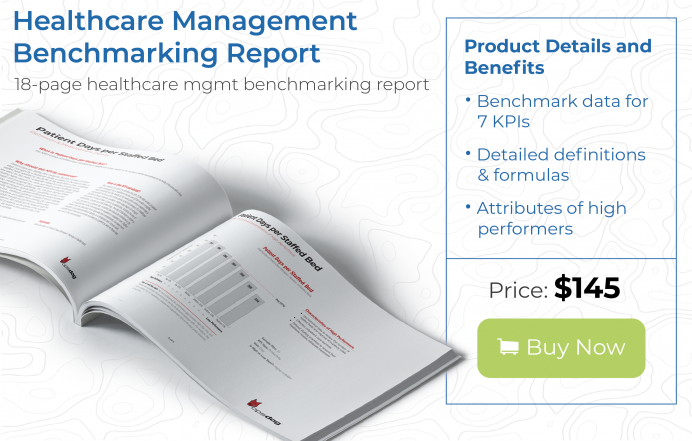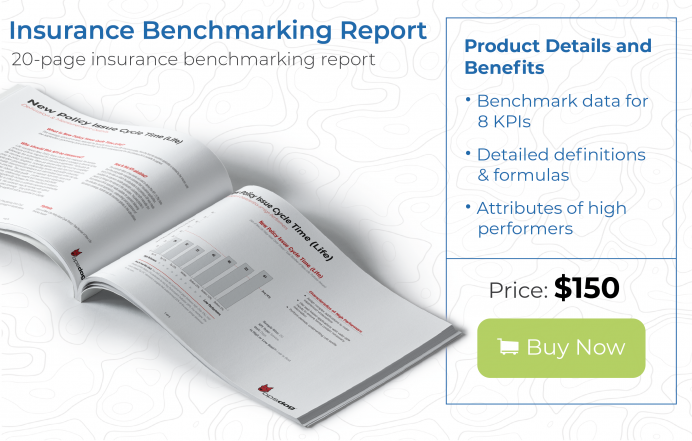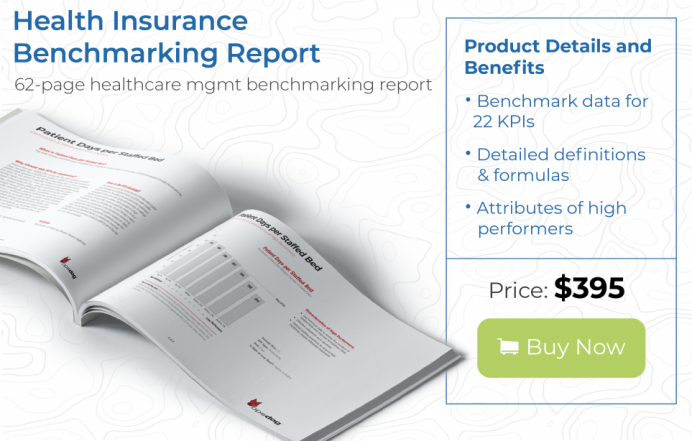The cost of healthcare continues to outpace inflation. The Centers for Medicare & Medicaid Services (CMS) predicts that U.S. healthcare spending will reach nearly $6 trillion by 2027, accounting for 19.4% of GDP. All stakeholders in the healthcare ecosystem—including health insurance companies–are facing increased pressure to reduce health care costs.
Benchmarking is one tool that health insurance companies can use to measure their operational efficiency and identify areas to lower costs.
What is Health Insurance Benchmarking?
The health insurance industry is highly regulated. For example, the Affordable Care Act (ACA) effectively limits insurer profits by capping total administrative costs and mandating how much they must reinvest on medical claims and quality improvements. Under regulations such as ACA, health insurers need to keep a close eye on their operational costs.
In addition, the industry is intensely competitive, with new entrants that promise lower costs and better member and provider experiences.
Enter health insurance benchmarking. By comparing key metrics to other insurers, such as how long it takes to settle claims or how accurately they estimate medical services costs, health insurers can identify areas in which they excel and areas in which they need to improve.
How to Use Health Insurance Benchmarks to Improve Efficiency
Once they analyze their benchmarking data, health insurance companies should look to correct the root causes of any issues. For example, insurers that have a high number of claims that aren’t resolved on the first submission could implement technology systems that are better integrated with the systems used by doctors, pharmacies, clinics, physical therapists, and other providers to automate claims intake and minimize data entry.
In fact, many health insurance benchmarks highlight problems caused by miscommunication between providers and insurers. While integrated technology can solve many issues, health insurance companies can also require providers to read insurer contracts thoroughly and sign off on them, pre-adjudicate claims or adjudicate them in real-time to estimate patient responsibility, and implement more rigorous methods for verifying patient eligibility.
Health Insurance Benchmark Examples
Here are five important benchmarks that health insurers can use to improve their operational efficiency, reduce costs, and deepen their relationships with healthcare providers and policyholders.
Health Insurance Benchmark #1: Benefit Accuracy Rate
Health insurance benefits aren’t easy for policyholders to understand. They are often confused by how much they owe for health services based on deductibles, coinsurance, and copayments so they rely on their health insurer to process their claims correctly—the first time. Insurers who communicate incorrect patient responsibility amount negatively impact policyholder experience and can ruin the health insurer’s reputation. Inaccurate estimates also cost the insurer more if it pays more than the patient eligible amount and for rework.
To calculate the benefit accuracy rate, divide the number of correct health insurance claims by the total number of claims processed, as a percentage.
Health Insurance Benchmark #2: Contracted Fee Schedule Match Rate
The American Medical Association’s (AMA) contract fee schedule match rate estimates how much money a patient will owe and how much the insurance company will pay for various medical services. If the rates don’t match, expect pushback from policyholders, and healthcare providers resulting in hard to collect medical bills, rework, and disputes. Ideally, insurers want a match rate as high as possible.
To calculate the contracted fee schedule match rate, divide the number of claims payments that match the insurer’s fee schedule by the total number of claims payments, as a percentage.
Health Insurance Benchmark #3: Patient Eligibility Accuracy Rate
Healthcare providers rely on patient eligibility information to determine if a patient’s healthcare insurance will pay for a medical service they are recommending. Healthcare providers share this information with patients so patients can make an informed decision on their care based on their out-of-pocket expenses. If the eligibility information the insurer provides is incorrect—for example, if the healthcare provider tells a patient that an MRI is covered when it’s not–healthcare providers and their patients can dispute payment.
To calculate, divide the number of times patient eligibility information matched the insurer’s payment by the total number of claims paid, as a percentage.
Health Insurance Benchmark #4: Claims First Pass Resolution Rate
If claims have to be submitted multiple times due to missing or inaccurate information, everyone loses. Insurers and healthcare providers need to rework claims, resulting in higher operating costs. Plus, providers and policyholders get frustrated when their claims are not processed properly the first time. The most common reasons that insurers must rework claims are missing information, duplicate claims, and out-of-date submissions. A first-pass claim is a claim that receives full or partial payment or is transferred to the patient’s responsibility without the need for resubmission. The higher the claims first pass resolution rate, the better.
To calculate, divide the total number of claims resolved the first time by the number of claims paid, as a percentage.
Health Insurance Benchmark #5: Claim Settlement Cycle Time
How long it takes a health insurer to process and pay a claim has a big impact not only on the satisfaction of the healthcare provider and the policyholder, but a lengthy claims process also increases costs for insurers. If the amount of time it takes from when the claim is submitted to when payment is made is longer than other insurers, look at improving the productivity of claims employees and increasing the number of claims that can be paid automatically rather than requiring manual intervention.
To calculate, add the total number of days it takes to pay claims and divide that sum by the number of claims settled. Only use claims that were paid; don’t include subsequent claims submissions.
Final Thoughts
Rising healthcare costs are a critical challenge facing patients, providers, and health insurance companies. For health insurance companies, health insurance benchmarking can identity multiple areas for insurers to improve their claims processing, lower their administrative costs, and better their relationships with both health providers and policyholders.
Are you tasked with bringing your health plan operations into the future? Find out how to accelerate those efforts here!
For a full list of health insurance industry and other related insurance benchmarks, download our Health Insurance Benchmarking Report here.
If you require additional assistance in developing an inventory to benchmark health insurance metrics then you may find our Health Insurance Key Performance Indicator Encyclopedia helpful. For even more information on our Benchmarking Research and business intelligence implementation services, contact us here. OpsDog can help your health insurance company build a benchmark plan and provide you with presentation-ready, high-quality deliverables.





